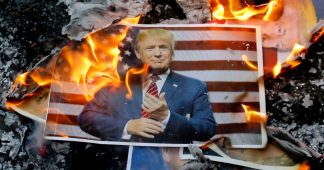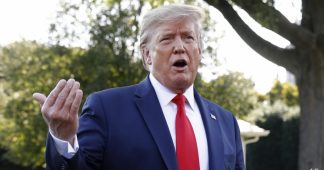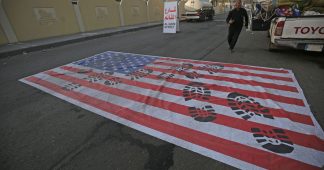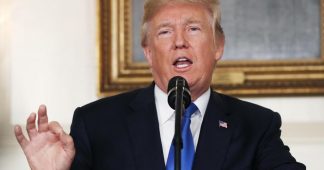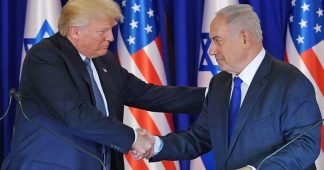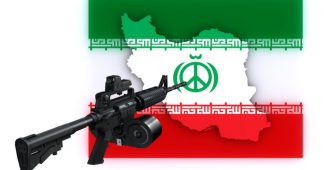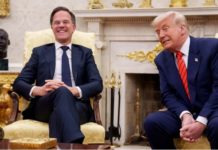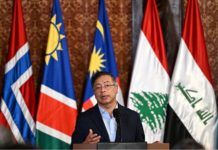By Bill Van Auken and David North
9 January 2020
The speech delivered Wednesday by US President Donald Trump in the wake of Iran’s firing of ballistic missiles against US bases in Iraq has been greeted by the corporate media as the easing of tensions that have brought the world to the brink of a catastrophic new imperialist war.
“Trump Backs Away From Further Military Conflict With Iran,” the New York Times proclaimed. CNN said that the US president was taking “the off-ramp in confrontation” with Iran. Others spoke of “relief’ and the war drive appearing to “deescalate.”
All of the talk of the war threat receding lacks even a shred of credibility. It has no more objective foundation than the claptrap in Trump’s speech about his desire for a “great future” for Iran and his readiness to “embrace peace with all who seek it.”
The war threat that was initiated with Trump’s abrogation of the 2015 nuclear accord between Tehran and the major world powers is only intensifying, as all the essentials of his remarks made clear. No one should have the slightest doubt that, to the extent that a direct military assault on Iran has been temporarily postponed, it will be all the more bloody and destructive when it comes.
Iran’s attack, in response to the assassination of General Suleimani, clearly was not intended to inflict casualties. But Washington views this not as a reason to “deescalate,” but as a tactical opportunity to pursue its strategic goals. The fact that there were no American casualties lessened pressure on Trump to order an immediate counterattack under conditions in which the United States was not prepared for all-out war. Because of the suddenness with which Trump ordered the assassination of Suleimani, the US military did not have time to undertake an offensive redeployment of forces. When the next inevitable provocation is staged, that tactical weakness will have been addressed.
Much of what Trump had to say was recycled from previous speeches and tweets denouncing and slandering both Iran and General Qassem Suleimani. But more important than anything that Trump said was the way in which his speech was staged. In an unprecedented violation of constitutional protocol, Trump addressed the nation flanked by the entire uniformed Joint Chiefs of Staff as well as Vice President Mike Pence, Secretary of State Mike Pompeo and Secretary of Defense Mark Esper. On all previous occasions, the announcement of a major crisis or a military engagement has been made by a president, seated at his desk in the Oval Office. This image was intended to present Trump as the leader of a military junta.
What was the message being sent by the military presence this time? Trump delivered an abrupt prelude to his remarks after walking to the podium: “As long as I am President of the United States, Iran will never be allowed to have a nuclear weapon.” He thus laid out a key pretext for a further attack on Iran before even saying “Good morning.”
The appearance of Trump was that of a man struggling to maintain control over himself. He was red-faced and breathing heavily. It is hard to avoid the conclusion that the public appearance had been preceded by furious arguments behind closed doors.
Over the previous week he had delivered numerous threats, vowing to hit Iran “harder than they have ever been hit before” and delivering via Twitter a “notification to the United States Congress that should Iran strike any US person or target, the United States will quickly & fully strike back, & perhaps in a disproportionate manner.”
Why did Trump fail to act on his threats? It is more than likely that the Joint Chiefs of Staff warned Trump that precipitous action could result in a military disaster.
The Pentagon needs time to prepare the defense of some 70,000 US troops deployed on Iran’s borders from Afghanistan to Turkey, along with tens of thousands more military contractors and naval personnel stationed in the region. The military knows that the next round of US attacks will probably be answered with a rain of Iranian missiles on US bases, airfields, battleships and aircraft carriers. In the run-up to the US wars against Iraq in 1991 and 2003, Washington needed several months to prepare against a far less potent enemy.
There are also political considerations by Washington’s war planners. More time is needed to develop pro-war propaganda and psychologically condition the population for levels of violence unknown since the end of World War II. This propaganda will include efforts to condition the American people to accept the use of nuclear weapons by the United States, with the assistance of the pliant corporate media. The mass protests in Iran and throughout the Middle East provoked by Suleimani’s killing provided an indication of the upheavals that will be unleashed by an all-out US war, especially as the working class is entering into mass struggles across the globe.
The only two substantive elements of Trump’s speech were his vow to impose “additional punishing economic sanctions” and his demand that NATO “become much more involved in the Middle East.”
No details were given about the new sanctions, and it is difficult to imagine how much further Washington can intensify its “maximum pressure” campaign to crash Iran’s economy and starve its people into submission.
As for NATO, Washington is once again attempting to assemble its “coalition of the willing” as in 2003. It has every reason to believe that it can bring the European powers on board in its preparations for a criminal war, given their craven response to the Suleimani assassination, in which they concentrated all their denunciations on Tehran. Like US imperialism, capitalist Europe is being driven to war by its own internal contradictions and mounting social tensions.
A war against Iran would inevitably be accompanied by the abrogation of the most elementary democratic rights at home. One of the extraordinary passages of Trump’s speech, delivered before the military high command, accused the Obama administration of funding terrorism and paying for the missiles fired at US bases by signing the 2015 nuclear accord that unfroze Iranian deposits in US accounts. This amounts to an accusation of treason against a former American president and is only a foretaste of how the US government would deal with mass opposition to war among American workers and youth.
A US war against Iran would far eclipse the catastrophe inflicted upon the region and the more than one million killed in the war against Iraq launched nearly 17 years ago. It would threaten to drag in the entire region and, indeed, the entire world.
No one should be under the slightest illusion that this will stop Washington from launching this war. Millions of people all over the world are watching with horror as the US ruling class, to use Trotsky’s phrase from 1938, “toboggans with closed eyes toward… catastrophe.”
All claims that Trump’s delay of military strikes against Iran opens up a path toward peace makes the mistake of separating Trump’s actions from the underlying crisis that has driven American foreign policy for 30 years.
Nothing that has happened in the last two days has changed the military objectives of the United States. The same geopolitical imperatives that brought about this week’s crisis will bring about new ones.
This war threat is the end product of the entire reckless militarist policy pursued by US imperialism since the dissolution of the Soviet Union in 1991. A series of wars of aggression and regime-change operations, from Afghanistan and Iraq to Libya and Syria, has produced only disasters while achieving none of Washington’s strategic aims. The US now faces even the prospect of its troops being thrown out of Iraq.
Preparations for war against Iran are bound up with the global strategy announced by Washington in 2018 based on a shift from the “war on terrorism” to the preparation for wars arising from “great power competition.” The imposition of a colonial-style puppet regime in Tehran and control over the Persian Gulf’s energy supplies are seen by Washington as an essential preparation for war with Russia and China.
And, while a war against Iran may prove tremendously bloody, that not will stop a ruling class that is preparing for a nuclear conflagration.
There is no longer any question if a war will be launched against Iran, but only when. Just as a pretext was invented for murdering General Suleimani based on a fabricated “imminent threat,” so a real or fabricated attack on US forces by anyone, anywhere in the Middle East, or another claim of a supposed “threat,” will be enough justification for imperialist aggression.
A war will not be stopped by the cowardly ostensible political opponents of Trump in the Democratic Party, who have served as the political mouthpieces of the military and intelligence apparatus in opposing his administration for being not sufficiently aggressive against Russia.
Nor will it be halted by any of the world’s governments, including the maneuvers of the bourgeois clerical government in Tehran, which seeks to reach an accommodation with imperialism even as it confronts mass opposition from below.
Any appeal to the rationality of the world bourgeoisie against war is pointless, as war itself arises directly out of the irrationality of capitalism and the insoluble contradiction between the nation-state system and world economy.
Trump’s delaying tactic must not lead to any letup of the fight to build a socialist movement against war. The most urgent and immediate task is to connect the struggle against war with the global upsurge of working class struggle, which provides a powerful foundation for the emergence of a mass antiwar movement directed at putting an end to imperialism and reorganizing society on socialist foundations.
Published at https://www.wsws.org/en/articles/2020/01/09/pers-j09.html
